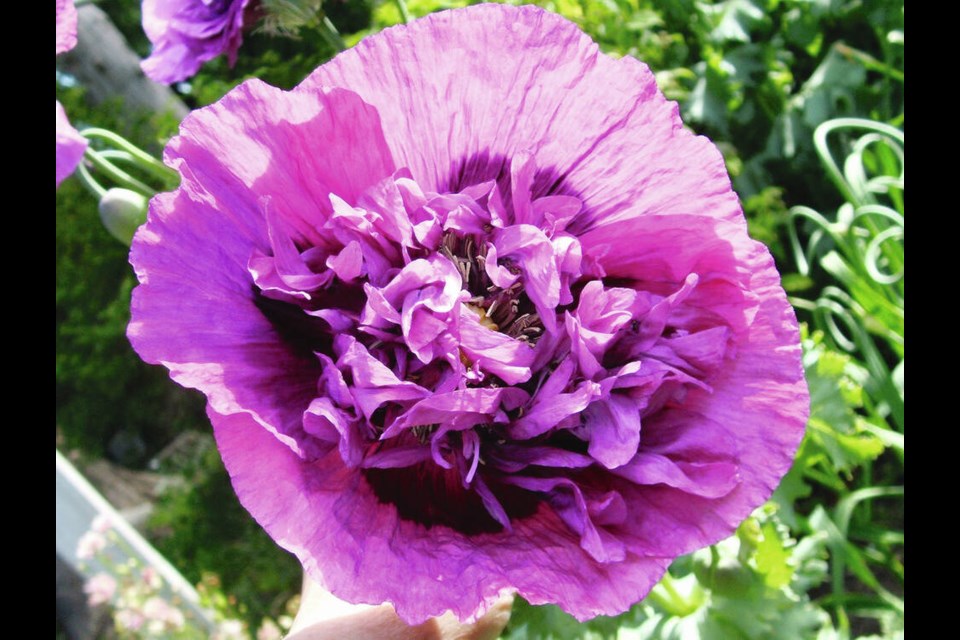Dear Helen: I have seeds for some big, large-flowered annual poppy plants that I’d like to grow as accents in pockets of the vegetable plots. I’m told they have large, wavy, blue-green leaves and flamboyant blooms. Can I plant the seeds outdoors? When?
S.P.
Your seeds are for the annual breadseed or peony-flowered poppy. The sturdy plants grow about a metre tall an produce single and double flowers in a gorgeous array of colours.
This poppy plant often appears uninvited in gardens, perhaps from seed dropped by birds. They self-sow. Once you’ve grown them, they usually will pop up here and there every year afterward.
Following bloom, seed pods develop and mature to a dry stage as seeds ripen within them. The seeds are used in baking.
March is my preferred month for sowing these poppies. Another lovely and useful annual flower I sow outdoors this month is calendula, which I often use as an edging for vegetable plots. It’s another easy, fast-growing annual flower available in a wide variation in the yellow, apricot, orange and cream range. The petals are edible.
Dear Helen: I was interested in your article a while back on squash and am curious about the nature of the “curing” period before storing winter squash at cool temperatures.
O.B.
Not everyone does this, but a seven to 10 day period of warmth, around 27 C, following harvesting and cleaning squashes does have benefits.
The “curing” period helps to further harden the skins for successful storage. It accelerates healing in any cuts or scratches, enhances colour and flavour, and works to complete ripening in slightly under-mature fruits.
Dear Helen: What should I be doing with snow pea, sweet pea, onion and spinach seedlings that have grown to around 10 cm in small pots, where they are quite crowded. Should I be fertilizing them? Can they be transplanted into the garden now?
E.W.
Direct outdoor sowing is preferred for snow peas and spinach. Now you have them up and growing, when to transplant into the garden will depend on the weather, which has been rather wildly fluctuating. Usually, late March to early April will work well provided the soil is no longer wet and temperatures have begun warming a little. Meanwhile, depending on weather forecasts and your taste for risk, you could either transplant the seedlings into larger pots pending the move outdoors, or do a trial transplanting into the garden, perhaps under plastic tunneling to begin with to keep them as warm as possible.
Onions and sweet peas are usually transplanted in late March or early April. Either risk transplanting them in the garden or move them temporarily to larger pots. Sweet peas can also be seeded outdoors in early to mid-spring.
Dear Helen: In a recent column you mention that you make your own fertilizer. Would you please share the recipe? D.H.
Ready-made, natural-source fertilizer blends are available at some garden centres and farm supply stores. They are made with ingredients such as seed meals and feather meal to provide nitrogen, bone meal or rock phosphate to supply phosphorus, and kelp meal for potassium and a wealth of micro-nutrients.
Nitrogen (N), Phosphorus (P) and Potassium (K) are the three macro-nutrients represented on fertilizer labels in the N-P-K order.
To make a balanced, all-purpose fertilizer, I mix these ingredients:
4 parts (by volume) seed meal or meals (alfalfa, canola, cottonseed)
1 part lime (to counter the acidity of seed meals)
1 part rock phosphate (preferably soft rock phosphate)
OR 1/2 part each bone meal and rock phosphate)
1 part kelp meal
Over the past several decades I’ve used only natural-source fertilizers, along with compost, in my garden to successfully grow a broad range of vegetables, fruits, and ornamental plants.
GARDEN EVENTS
Home orchards. Dinter Nursery, 2205 Phipps Rd. in Duncan, is presenting a workshop on “Planning your home orchard” on Sunday, March 17, from 10 to 11 a.m. With planning, fresh fruit can be harvested from our gardens from August until storage varieties are used up in the New Year. Bernie Dinter will explain how an understanding of fruit tree management can lead to increasing yields. Cost is $10 plus GST. Space is limited. Register in advance at the nursery or at 250-748-2023.



